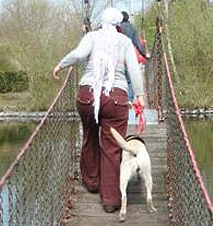A mobility dog is a dog who helps a person with reduced mobility, who either is in a wheelchair or has to use crutches.
The reasons for physical disabilities are as numerous as the duties that mobility dogs have to carry out. Mobility dogs are trained for a variety of illnesses, including multiple sclerosis, spina bifida, Parkinson's, cerebral palsy, muscular diseases, spinal injuries, fibromyalgia, and the consequences of accidents, to name just a few. Each mobility dog learns individual tasks which will help its partner.
Mobility dogs, along with guide dogs, are the oldest and most well-known type of assistance dog. The first mobility dogs were trained in the USA in the 1970s. Mobility dogs can be trained for children, as well as for adults. Depending on the individual situation, the dogs will either be trained in self-training, or be trained by someone else.
- The duties of a mobility assistance dog
Mobility dogs support their partner on a day-to-day basis by carrying out individual duties. They turn the light on and off, open and close doors, cupboards and drawers. The help their partner to stand up, help with dressing and undressing and pick up objects that have fallen on the floor. Mobility dogs carry objects for as long as necessary, until their partner needs them, when they place them directly in the hand. They can even pick up and bring delicate objects, such as glasses, bank notes, sheets of paper and bank cards. A mobility dog can take a wallet out of the bag on a wheelchair and give it to the cashier. The dog can also learn to fill and empty the washing machine and fetch items from the supermarket shelves on command. A mobility dog learns to walk next to the wheelchair on a loose lead, to change sides on command and to follow behind the wheelchair, according to requirements. At home the dog can bring the wheelchair to another room and naturally, like all assistance dogs, it ignores passers-by and other dogs.
- Scientific studies on mobility dogs
Various studies have been carried out over the years looking at the influence of mobility dogs. All the studies came to the conclusion that mobility dogs have a consistently positive influence on their partners. In 1987, Hart, Hart and Bergin carried out a study in the USA, which looked at the social influence of mobility dogs on their partners. A mobility dog team were told to go into the city center, once with the assistance dog and once alone. The subject had eight friendly interactions while with the assistance dog and only one while alone.
In 1993, McCulloch and Valentine et al. found out that feelings of self-worth increased with a mobility dog. Additionally, assertiveness, confidence, independence and happiness all increased. 90% of the mobility dog partners reported that they were more independent and less lonely since they had received a mobility dog.
A 1996 study by Hart et al. reported that 75.7% of mobility dog partners improved their relationships with friends, family members and society after they got a mobility dog. In 1996 Allen and Blascovich also carried out a study with 48 people with physical disabilities. The study showed that, within six months of a fully trained mobility dogs moving in, positive effects on the minds of the participants increased. These positive effects increased in the following two years as the partnership between dog and participant grew.
In 2006, at the annual rehabilitation conference in the USA, a study on mobility dogs was presented. The conclusion of the study was that mobility dog partners were less reliant on family and friends to get by in their day-to-day life than those who did not have a mobility dog. The mobility dog partners required on average 4.3 hours less help from family and friends than others with a physical disability. A 2008 study by Texas Hearing and Service Dogs came to a similar conclusion. The mobility dog partners were satisfied with their mobility dogs and all reported that they were less dependent on other people, and that the amount of hours with care-workers could also be reduced. The mobility dog partners reported moreover that they felt more able to go into public with their mobility dogs, and felt more independent and secure when there. They reported that more people in public spoke to them, and that their self-confidence grew after getting a mobility dog.
- Preconditions for getting a mobility dog
- You or your child suffer from a physical disability, which restricts you in your day-to-day life, and means that you rely on crutches or a wheelchair. Or you suffer from a progressive disease, such as multiple sclerosis, and expect that you will require crutches or a wheelchair in the near future.
- You want an assistance dog who will reduce your limitations in day-to-day life, and you are willing to develop a strong bond with the dog.
- You want to spend 24 hours a day with your assistance dog.









